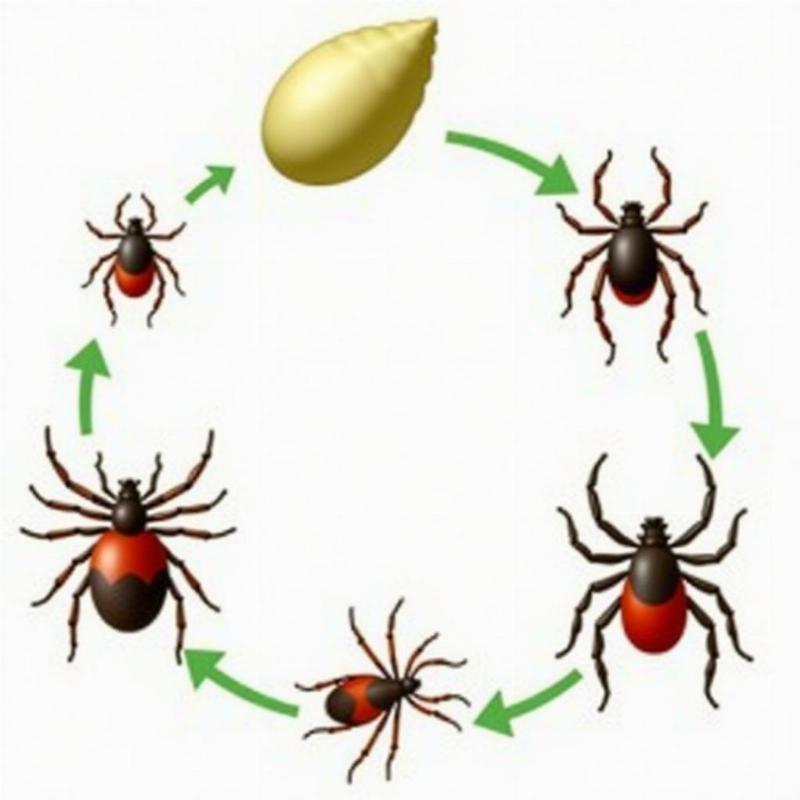Flea and tick infestations are a common concern for dog owners across the US. While there are many commercially available products, some pet parents explore natural remedies like cottonseed oil. But is cottonseed oil for dogs a safe and effective way to combat these pesky parasites? This article dives deep into the topic, exploring the benefits and risks, and offering guidance on safe flea and tick prevention strategies for your furry friend.
Understanding the Flea and Tick Problem in the US
Fleas and ticks are more than just a nuisance; they can transmit serious diseases to our canine companions. Lyme disease, Rocky Mountain spotted fever, and ehrlichiosis are just a few examples of the health risks posed by these parasites. In the US, the prevalence of these parasites varies by region and climate, making effective prevention crucial nationwide. Understanding their lifecycle and preferred environments is the first step towards protecting your dog.
 Flea and Tick Life Cycle Diagram
Flea and Tick Life Cycle Diagram
Cottonseed Oil for Dogs: Benefits and Risks
Cottonseed oil is touted by some as a natural flea and tick repellent. It’s believed that the oil creates a barrier on the dog’s coat, making it difficult for parasites to latch on. Some proponents also suggest that it can suffocate existing fleas and ticks. However, there’s limited scientific evidence to support these claims. While cottonseed oil is generally considered safe for dogs in small amounts (for example, as an ingredient in dog food), applying it directly to their skin can pose risks. Some dogs may be allergic to cottonseed oil, leading to skin irritation, itching, and even hot spots. Furthermore, the thick, oily residue can attract dirt and debris, potentially worsening skin conditions.
Safe and Effective Flea and Tick Prevention Methods for Dogs
Protecting your dog from fleas and ticks requires a multi-pronged approach. Consult with your veterinarian to determine the best strategy for your dog’s specific needs and lifestyle. They can recommend appropriate preventative products based on your dog’s breed, age, health status, and exposure risk. These products are generally available as topical treatments, oral medications, or collars.
Natural Remedies: Exploring the Alternatives
Alongside conventional treatments, some natural remedies can offer supplemental protection. Regular grooming, including thorough brushing and bathing, can help remove fleas and ticks. Keeping your yard clean and free of tall grass and leaf litter can also reduce tick populations. Certain essential oils, like cedarwood and lavender, are believed to have repellent properties, but it’s crucial to use them with caution and under the guidance of a veterinarian, as they can be toxic to dogs if ingested or applied incorrectly.
Creating a Flea and Tick-Free Environment
Maintaining a clean home environment is essential for minimizing flea and tick infestations. Regularly vacuuming carpets, rugs, and furniture, especially in areas where your dog spends the most time, can help remove flea eggs, larvae, and pupae. Washing your dog’s bedding in hot water and drying it on high heat can also kill any lingering parasites.
Choosing the Right Prevention Strategy for Your Dog
The ideal flea and tick prevention strategy for your dog will depend on several factors, including their lifestyle, the prevalence of parasites in your area, and any existing health conditions. Working closely with your veterinarian, you can develop a personalized plan that provides the best protection for your furry companion.
Conclusion
While cottonseed oil for dogs might seem like a natural solution for flea and tick prevention, its effectiveness is questionable and it may pose certain risks. A comprehensive approach, including veterinarian-recommended products, regular grooming, and environmental control, offers the best protection for your beloved pet. Prioritizing your dog’s health and well-being will ensure they remain happy, healthy, and parasite-free.
FAQ
- How often should I treat my dog for fleas and ticks? The frequency of treatment depends on the specific product you use. Always follow your veterinarian’s recommendations and the product label instructions.
- Can I use human flea and tick products on my dog? Never use human flea and tick products on your dog. These products can be toxic to dogs and cause serious health problems.
- What are the signs of a flea or tick infestation on my dog? Common signs include excessive scratching, biting, licking, hair loss, and visible parasites.
- How can I prevent fleas and ticks in my yard? Keep your yard clean, mow the lawn regularly, and remove leaf litter and debris. You can also consult with a pest control professional for additional preventative measures.
- What should I do if I find a tick on my dog? Remove the tick promptly using tweezers, grasping it as close to the skin as possible. Clean the area with antiseptic and monitor for any signs of infection.
- Are there any natural flea and tick repellents for dogs? Some essential oils, like cedarwood and lavender, are believed to have repellent properties, but always consult with your veterinarian before using them.
- How often should I check my dog for ticks? Check your dog for ticks daily, especially after they’ve been outdoors in wooded or grassy areas.
Beautdogs.us is your premier destination for comprehensive dog care information and resources in the US. We provide expert advice on breeds, grooming, training, health, and nutrition to help you navigate the joys and challenges of dog ownership. Whether you’re a seasoned dog parent or just starting your journey, Beautdogs.us is your trusted source for all things canine. Contact us today for personalized guidance and support. Email: [email protected], Phone: +1 501-555-7529. Visit Beautdogs.us to learn more!